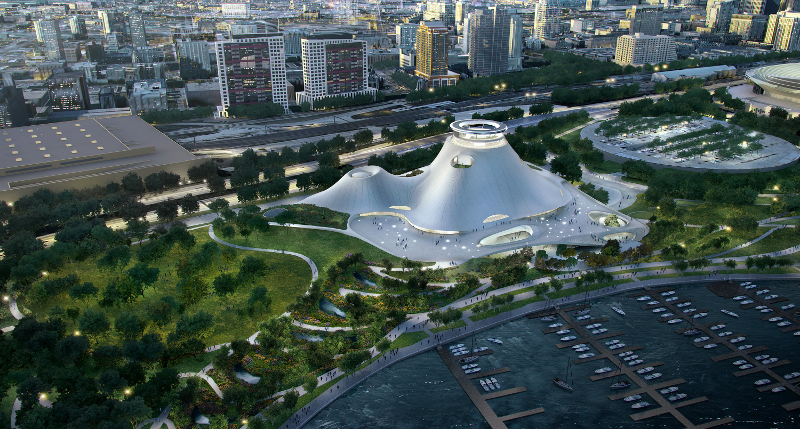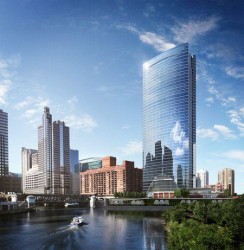New Chicago Architecture Opens Nov. 12 – Highlighting New Buildings and Urban Planning Projects that Continue Chicago’s Rich Tradition of Leading Contemporary Design

Opening Reception to Benefit the Reopening of the Museum’s Daniel H. Burnham Center
New skyscrapers, corporate headquarters, hospitals, museums, schools, airports, institutional buildings, interiors, single-family homes, multi-family high-rises, renovations and restorations, parks and urban revitalization projects—many destined for the shores of Lake Michigan, as well as cities around the world—are the subject of a landmark exhibition and book organized by The Chicago Athenaeum: Museum of Architecture and Design and The European Centre for Architecture Art Design and Urban Studies.
Curated by Christian Narkiewicz-Laine, New Chicago Architecture opens November 12 at 332 South Michigan Avenue with a Benefit Reception for the reopening of The Chicago Athenaeum’s new Daniel H. Burnham Center and continues on view for the general public through November 17.
The exhibition contains buildings and urban planning projects by over 100 architecture offices in Chicago and around the world. Chicago is the third-largest city in the United States and home to headquarters of more than 400 corporations—29 on the Fortune 500 list.
The Chicago exhibition is sponsored by DXV by American Standard, Hines, Ivanhoé Cambridge, Lightology, and Otis Elevator Corporation.
After Chicago, the exhibition travels to Milan, Athens, Hong Kong, and other cities inside Asia and Europe.
“The scope of the exhibition,” states Narkiewicz-Laine, “is nothing less than remarkable. Some of the world’s greatest design visionaries, thinkers and builders are contributing to Chicago’s current, but long-standing legacy, as the world’s first city of modern architecture. These are, in fact, some of Chicago’s best new buildings in decades. The exhibition demonstrates the one-of-a-kind design exuberance and design quality that other cities could only envy, but should also emulate in making our world cities more humane and robust centers of culture and commerce.”
“The checklist of buildings and urban planning projects contained in New Chicago Architecture,” continues Narkiewicz-Laine,” are drawn from submissions to The Chicago Athenaeum’s prestigious annual American Architecture Awards.
“The result is a greatest-hits mash-up of new city icons, buildings that blend the excesses of ‘starchitectural’ culture into one, well-seasoned urban potage.”
At the top of the list of Chicago’s new grands projects is the avant-garde scheme for the new futuristic Lucas Museum of Narrative Art (LMNA) by the Chinese architect Ma Yansong of MAD Studios in Beijing. The curved, white stone building with extremities that extend into the landscape creates a platform above the main entrance. At the highest point, a flat top is covered by a “floating” disc, forming a sheltered viewing area that offers visitors vistas of Chicago and Lake Michigan.

Likewise, the new renovation of Chicago’s Navy Pier by the New York office of James Corner Field Operations is transforming the Chicago’s Lake Front with an articular flair for urban situations, public spaces and an ecologically smart and culturally significant built work of lasting distinction.
The 25-acre Maggie Daley Park, part of a “Second Wave” of new park building, by New York landscape architect Michael Van Valkenburgh, is a text book example of what a 21st-Century modern urban park should be with its play garden and its Enchanted Forest of 3,590 square feet of networked pathways. Van Valkenburgh’s 606, the city’s most ambitious park project and second act for a decaying and dying infrastructure, forges new public spaces off the Lakefront from West Town to Lakeshore East and transforms nearly 100 acres with the excitement of inventive design unlike anything else seen in any world-class city.
Other star firms outside of Chicago, but building projects for the city include: Pelli Clarke Pelli, Rafael Viñoly Architects, HOK, Gensler, Ann Beha Architects, Pickard Chilton Architects, Santiago Calatrava, and Foster + Partners. These leading firms have contributed to the city’s rich architectural tradition leaving their indelible fingerprints on several key buildings. The failed Chicago Spire by the celebrated Swiss/Spanish architect Santiago Calatrava, signals a significant loss to Chicago’s signature skyline and unique collection of world-class landmarks.
While the city imports architectural talent to its contemporary scene, several important Chicago offices are leaving their imprint on skylines across the world.
The $20 billion mesmerizing Kingdom Tower by Chicago’s Adrian Smith + Gordon Gill Architecture (AS + GG) under construction in Jeddah, Saudi Arabia is set to be the world’s tallest building at over 1000 meters. The building is an incarnation of Frank Lloyd Wright’s Mile High skyscraper and represents new growth and high-performance technology fused into one powerful iconic form. More equally remarkable projects by the firm are destined for Shanghai, Seoul, United Arab Emirates, Azerbaijan, Kazakhstan, Malaysia, Chenghu, and Beijing.
Other urban sky towers by JAHN, from Berlin and Munich to Guangzhou and Tokyo, symbolize a triumph for design made in Chicago’s sleek, pristine modernist style. Ralph Johnson of Perkins & Will proffers a distinctive humanist approach to projects in Luanda, Angola and Nairobi, Kenya—stunning masterpieces of crisply designed modern academic buildings with painstaking attention to sustainability.
Goettsch and Partner’s robust projects, Chancheng Greenland Center, SIP Zhongnan Center, and Suzhou Greenland Mixed-Use, all in China, add contextual flavor and smooth and lustrous modern designs as leading urban icons in several of China’s burgeoning metropolises.
Goettsch’s heroic SIP Zhongnan Center’s tower features a gently tapered profile is like silk strands or a flowing garment, each façade is articulated by a sinuous vertical line that acts as both reveal and overlapping edge as it travels up the building to resolve itself in an iconic expression at the top. At the base of the building, the reveal migrates to the corner and “pulls” the exterior wall out (like an opening in the garment) to define areas for entry. At the top, the reveal widens to become an aerie, light-filled volume providing dramatic views to the city beyond as well as up through a glazed roof to the upwardly-thrusting forms of the building crown’s towers.

Back at home, Goettsch’s new renovation of Graham, Anderson, Probst & White’s landmark Wrigley Building sympathetically and intellectually removed previous, awkward “modernizations” and replaced them with appropriate reinterpretations of the original designs, including a return of the original historic volumes and utilizing 1920’s materials.
On the Chicago skyline, Pickard Chilton Architects’ new 52-story, sculpted River Point offers dramatic world-class architectural design to its unique location and draws significant renewed vitality to the Chicago River.

Another new river project, by Studio Gang Architects, Wanda Vista Tower, demonstrates a light-headed architectural exuberance effectively channeled through the last two decades of architecture’s more extravagant tendencies into one great leap onto Chicago’s skyline. It is the kind of arms-length statement architecture that
has been incubated in the anything-goes climes of China and the Middle East for the past few years now on Chicago’s front door.
“In an age of accelerated change,” states Christian Narkiewicz-Laine, “today’s Chicago architects are forging a new direction and developing an extraordinary range of new visionary ideas that test the limits of the realms of everyday life and everyday building with a network of architectural talent infused with new exploration, new objectives, new aspirations, and new experiments to shape the world’s environment around us.”
The opening reception for New Chicago Architecture on November 12 at 6:00 PM forms a benefit to reopen the Museum’s Daniel H. Burnham Center, which had been located for years at 6 North Michigan Avenue until the Museum lost its lease.
Individual tickets are $100 and are available by contacting the Museum at +815/777-4444.
The exhibition continues through November 17. Exhibition hours are 10:00 AM through 4:00 PM.
A 450-page book published by Metropolitan Arts Press, entitled New Chicago Architecture, accompanies the exhibition with a publication date in December.
After Chicago, New Chicago Architecture starts a world tour starting in Milan this spring and continues in Europe and Asia.
For more details, visit The Chicago Athenaeum’s website at wwww.chi-athenaeum.org
About The Chicago Athenaeum (www.chi-athenaeum.org) is a global nonprofit education and research institute supported by its members with offices and cultural centers in Dublin, Athens, and Milan. Its mission is to provide public education about the significance of architecture and design and how those disciplines can have a positive effect on the human environment.





